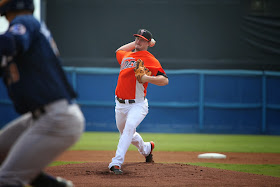 |
| Mike Wright is one of the Orioles' better pitching prospects. (Elaina Ellis / Norfolk Tides) |
Normally, the last game of a minor-league season, typically held on Labor Day, is taken somewhat less than seriously. The crowds are small; many of the players are recent arrivals; and almost all of the players want to get the game over with and go on. However, 2013 was different. The Tides needed to win to qualify for the International League playoffs, and were playing slightly harder than usual. Durham, on the other hand, had wrapped up its division title and had nothing else to play for. So Wright's performance may not mean as much as a normal start.
Wright pitched a good game. His basic boxscore line was 6 2/3 innings pitched, 6 hits, 0 runs, 0 walks, and 2 strikeouts, for a game score of 64. Since Durham was not interested in working the count, Wright probably was able to pitch longer than usual. His walks and strikeouts may also be lower than typical. Nevertheless, it was a good start.
Wright faced 26 batters:
Ground balls: 8
Fly balls: 11
Line drives: 5
Strikeouts: 2
This includes base hits, so the G/F ratio is different from the published totals, which only include outs. Wright wasn't a groundball pitcher in this game, which doesn't appear to be his usual pattern.
His pitches:
Balls: 31
Swinging strikes: 6
Called strikes: 17
Foul balls: 18
In play: 19
Wright didn't demonstrate swing-and-miss stuff. Below are the number of pitches he threw with various counts:
0-0: 26
1-0: 11
0-1: 13
2-0: 2
1-1: 11
0-2: 6
3-0: 1
2-1: 3
1-2: 10
3-1: 1
2-2: 7
3-2: 2
Because of the game circumstances, I wouldn't read too much into this data. He generally worked ahead of hitters and only made four pitches with a three-ball count. Three of those four pitches were in the same at-bat; he fell behind 3-0, worked the count to 3-2, and then the batter put the ball into play.
This game fits the classic profile of an innings-eating #4 or #5 starter. Mike Wright got ahead of batters without swing-and-miss stuff. He showed good control and worked efficiently. The best pitchers of his type will have one or two good years in the rotation before becoming injured or ineffective. Others are Josh Stinsons, who spend years in AAA starting rotations hoping for and occasionally getting a few big-league innings. Wright will likely start 2014 at Norfolk and we'll see what happens next.
No comments:
Post a Comment